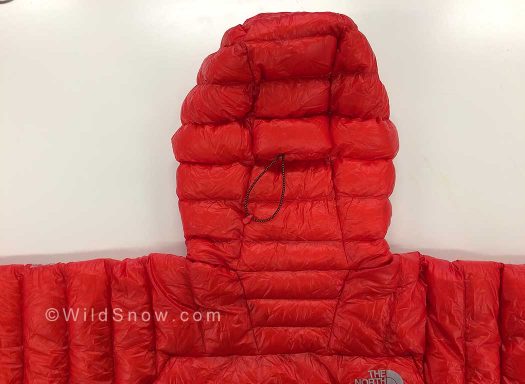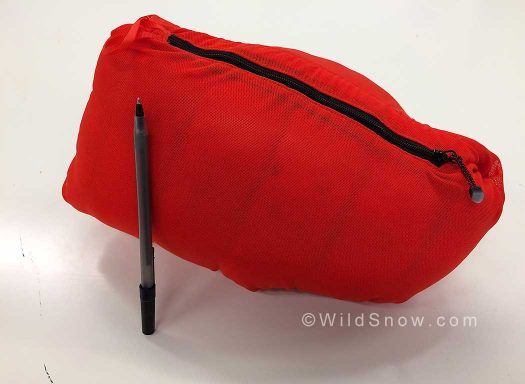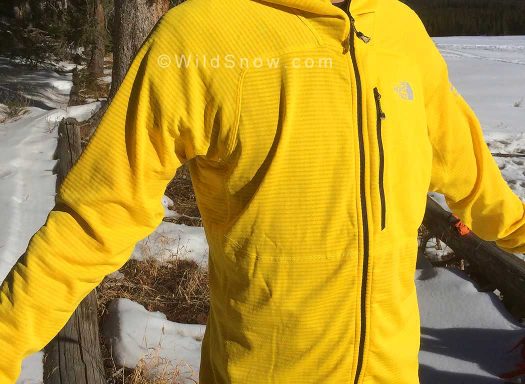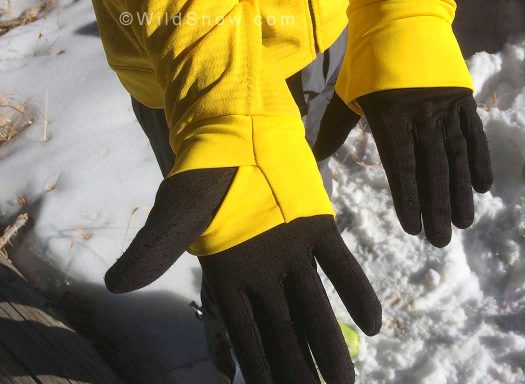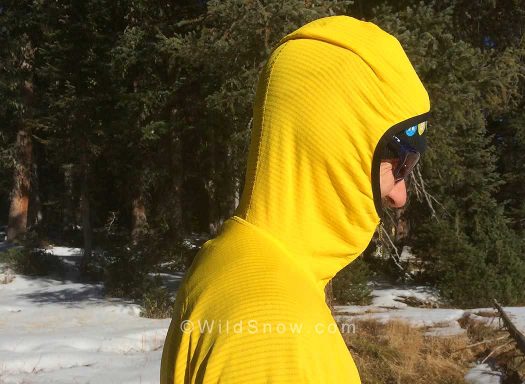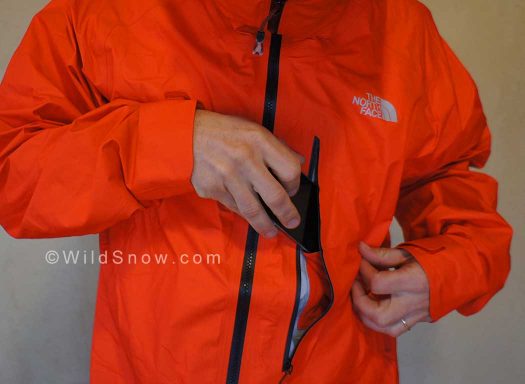For extreme cold weather testing, come to to my town, Gunnison, Colorado. That’s what BMW does. Every winter the famous German auto company brings their prototype vehicles here, wraps them in camo, and drives them around for a week. They count on temperatures likely dropping sub zero Fahrenheit — not uncommonly thirty below.
The North Face must have taken a tip from the Germans when they sent their new “Summit Series” ski mountaineering line of clothing here to “Sunny Gunny” for cold weather testing. It happened to be the same week the Bimmer crew drove into town. I’m no pro engineer from the European labs, but I still know how to send a piece of gear through some real world gauntlets, and live in the right place to do it.
This specific line of equipment is known as the “Summit Series,” which is a selection of clothing “designed to be a unique and complete skimo system.”
First up, the Summit L3 Proprius Down Hoodie. This 800-fill goose down jacket is clearly too warm for racing uphill. But that’s fine with me, I’m not a racer. Instead, this lightweight puffy is made just for people like myself, who show up to a trailhead well before sunrise at the coldest hour of the day, and begin skinning up the mountain with headlamps and frozen boogers. We’re completely comfortable to start the climb with too many layers on; we’ll shed the puffy when we’re above the inversion.
So upon first look, I was excited to put on the lightest 800-fill hoodie I’d ever laid eyes on (I measured 13 oz. on my home scale). First, I wore it on an early morning walk around town on our first day of below zero temps. Only disappointment, no hand pockets and only one large chest pocket (more on this later). This jacket was, however, remarkably warm.
Next, I brought the Proprius up to nearby Monarch Mountain ski resort for early morning uphilling. It was an even zero degrees F and slightly windy, so on went the down hoodie over my mid layer, North Face Summit L2.
Again, as I put a few accessories and snacks into the Proprius easy-access pockets, I was annoyed that there were no hand pockets. Then I strapped on my pack. My brain must have been a bit slow because my epiphany-of-the-day took longer than it should have. As I was walking to the base area, I noticed how comfortable the whole kit felt; especially at the hips. As I bent over to click into my skis and stood back up, I once again noticed how nice everything felt. Finally it hit me: if you don’t have pockets, zippers and little items in your waist and thighs, you’ll be more comfortable! (I realize some of you may have learned this a long time ago and have adjusted, but it took me until the ripe age of 36.)
Thus, in this case regarding hip pockets but in other ways as well, The North Face has created a system that is specialized and good at one thing: uphill/downhill skiing. Comfort and performance take priority, so we lose minor conveniences (like hand pockets). Every piece of this series nails it in the comfort category. For the Proprius Down Hoodie, I do appreciate the large chest pocket as a consolation — it swallows up my phone, headlamp, and a buff with ease. The chest pocket also acts as a stow-bag so you can compress the jacket and drop it in your backpack. This is important for me, since I like to carry a lightweight insulating jacket like this on every single trip, no matter the forecast, in case of injury or an epic overnight situation.
Hoods are also a big deal to me and I like to have them on nearly all of my tops, even for casual “townie” jackets. This pre-tensioned, helmet-compatible hood, with elastic binding and rear adjustment, once again nails it for comfort and performance. The drawstring is easy to find in the back and it opens up my peripheral vision without pulling the front of the hood off of my forehead. I have not worn it over a helmet yet, but I don’t foresee any problems as there is ample room. Following the theme of comfort, the shape at the waist, elbows and wrists all fits me perfectly and helped me enjoy the first fifteen minutes of my ascent up Monarch after which it was time to shed.
The layer I exposed as I heated up and dropped the down jacket was the previously mentioned L2 Proprius Grid Fleece Hoodie. I really like this layer. I can’t name any features that were left out or compromised in the design. The large chest pocket could swallow up just as much bulk as the L3 Down Hoodie, which would get awfully bulky. One little energy gu pouch is all I want in there, staying warm by my body. The North Face touts an “unparalleled warmth-to-weight ratio” using Polartec grid fleece. I do not disagree.
When I reached the ridgeline at Monarch, the reliable, chilly Continental Divide breeze was there to meet me like a trusty old friend. The L2 zipped up, hood went over my buff, thumbloops over my gloves and I slid on up the ridge, comfy and thankful I didn’t have to stop. The breathability checks out when the layer is exposed, and it is pretty impressive even under the down hoodie and a shell. This little shirt fits and functions so well, I’ve found myself wearing it casually around the house and around town, trail-running in the afternoons and nordic skiing with my family.
For the brisk descent down Monarch, I pulled out the L5 Proprius GTX Active Jacket. This is meant to be a burly, lightweight shell to complete the Summit series. My first impression is that the hood, shoulders and arms fit perfectly. So I was surprised to find the waist feeling huge and frumpy. Full disclosure here: I’m extra skinny, therefore I come across huge-feeling waists in clothing very often. But considering how well the other layers from the series felt, I was a bit disappointed.
Above being said, the Proprius GTX checked out everywhere else: another large chest pocket with an internal mesh media pocket inside, a large hood with a pleasant functionality similar to the L3 Down Hoodie, and adjustment tabs all easily operated with gloves on. Since this season it refuses to snow or rain in the high mountain valleys of Colorado, I have not been able to test the Proprius GTX waterproof capabilities, but I am confident it sheds rain and snow well enough for my purposes. More important to me regarding waterproof function is that a shell performs well for two or more seasons, after it’s been beat down, packed, and worn for a few months. I’ll revisit this review once said “beat down” is accomplished, possibly later this season.
Conclusion: The North Face accomplished the goal they set for themselves — to make a clothing “system” that performs exceedingly well for backcountry skiing. The L3 Down Hoodie is best used within these parameters: for leaving frigid trailheads, layering at the summit and keeping for an emergency layer.The L2 Grid Fleece Hoodie, on the other hand, is such a well made piece of clothing that it goes well beyond the niche borders it was made for. The L5 GTX Active Jacket falls somewhere in between, clearly excellent for battling a blizzard on a ridge, but being so light and breathable I’d probably happily take it along on summer adventures in the rain.
Living in one of the coldest regions in the U.S. is a matter of pride for many Gunnison locals, so we’re always happy to learn that our place can be of some use to BMW auto testers — as well as skimo gear testers. The flip side of the coin here in Colorado’s Rockies is that even on dreadfully cold days, it is also usually sunny, so if you’re hiking up a mountain, you are going to be de-layering and re-layering constantly. It is nice to see a clothing company take this layering system seriously and offer us some well-executed solutions.
(Guest blogger, Andy Sovick, owns Off-Piste Ski Atlas. A self-professed map-geek, Andy has been skiing Colorado’s backcountry his entire life. Raised on cross-country skis pulled from a dumpster in Fort Collins, he began his ski career following his parent’s tracks along Cameron Pass. Having perfected the classic wobbly telemark turn, and subsequent telemark face-plant, he moved to Durango, where he graduated from Fort Lewis College in Durango. He now resides with his wife and son in Gunnison, Colorado.)
Andy is the founder and owner of Beacon Guidebooks, a ski guide and mapping publisher. Author of Backcountry Skiing: Crested Butte Colorado, Andy has been skiing Colorado’s backcountry his entire life. Raised on cross-country skis pulled from a dumpster in Fort Collins, he started his ski career following his parent’s tracks along Cameron Pass. He moved to the Colorado’s western slope in 2000 and now resides with his wife and son in Gunnison. From woodworking to book writing, Andy is a craftsman to the core. He believes that sharing relevant information and photos about skiing the backcountry will help travelers spread out, get inspired to explore, and most importantly, make better and safer decisions.

